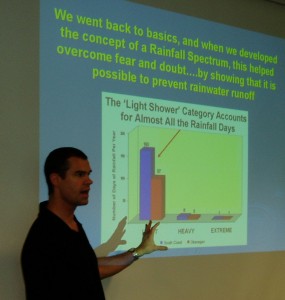Innovation in Rainwater/Stormwater Management in Canada: The Way Forward
Program of Regional Conferences
Rapid urban expansion, increased traffic, ageing infrastructure, greater climatic variability, and the need for enhanced sustainability of urban water resources pose significant challenges to conventional rainwater/stormwater management.![]()
“Innovative approaches are needed in order to mitigate the risk of flooding, pollution, and aquatic ecosystem degradation, and enhance beneficial uses of urban waters.” writes Hans Schreier of the Institute for Resources & Environment at the University of British Columbia, in an article published in the Water Quality Research Journal of Canada.
“To examine such approaches, a series of three regional conferences on innovative rainwater/stormwater management were held in Vancouver, Calgary, and Toronto during 2007 to 2008 under the sponsorship of the Canadian Water Network (CWN) and the Canadian Mortgage and Housing Corporation (CMHC).”
 Overview of Innovative Approaches
Overview of Innovative Approaches
Authors of selected conference papers providing information on innovative approaches to mitigating the risk of flooding and reducing pollution impacts at the property, neighbourhood, and watershed scales were then invited to submit journal papers, and the 10 accepted in the review process were included in a Special Issue of the Water Quality Research Journal of Canada. The papers selected for publication are listed as follows:
- Evaluation of Mitigation Methods to Manage Contaminant Transfer in Urban Watersheds
- Treatment Performance of an Extensive Vegetated Roof in Waterloo, Ontario
- Street Sweeping as a Method of Source Control for Urban Stormwater Pollution
- Effectiveness of Compost Biofilters in Removal of Sediments from Construction Site Runoff
- A New Approach in Measuring Rainfall Interception by Urban Trees in Coastal British Columbia
- Evaluation of Green Roofs for Runoff Retention, Runoff Quality, and Leachability
- Characteristics of Sediment Removal in Two Types of Permeable Pavement
- Sediment Assessment of Stormwater Retention Ponds within the Urban Environment of Calgary, Canada
- Developing Capacity for Large-Scale Rainwater Harvesting in Canada
- Culex Mosquitoes, West Nile Virus, and the Application of Innovative Management in the Design and Management of Stormwater Retention Ponds in Canada
 “An overview of the selected papers indicates that no single innovative measure is adequate under all circumstances, and a multi-barrier approach is deemed to be most effective,” continues Jiri Marsalek of the Water Science and Technology Directorate of Environment Canada in Burlington, Ontario. Jiri Marsalek is Chief, Urban Water Management Section. Career highlights include being the Leader of the UNESCO’s International Hydrological Programme project on urban water cycle processes and interactions.
“An overview of the selected papers indicates that no single innovative measure is adequate under all circumstances, and a multi-barrier approach is deemed to be most effective,” continues Jiri Marsalek of the Water Science and Technology Directorate of Environment Canada in Burlington, Ontario. Jiri Marsalek is Chief, Urban Water Management Section. Career highlights include being the Leader of the UNESCO’s International Hydrological Programme project on urban water cycle processes and interactions.
Property Level:
“Examples of innovations at the property level include harvesting roof runoff and reusing water, managing rainwater by infi ltration in swales and into soils in bioretention areas, minimizing impervious surfaces, and using pervious pavement.”
At the Neighbolurhood Level:
“At the neighbourhood level, runoff impacts are mitigated by designing roads without curbs, gutters, and drain pipes, and diverting runoff into infiltration channels, swales, and wetlands. Creating roads and parking lots with pervious pavement and draining runoff from such surfaces into infi ltration basins is also discussed. Among stormwater quality source controls, potential effects of street sweeping on runoff quality enhancement were assessed.
At the Watershed Scale:
“New innovations at the watershed scale include: (a) the creation of wide riparian buffer zones that can detain water, remove sediments, and mitigate nutrient export and other pollutant effects, (b) the minimization of channelization of streams and rivers, and (c) the designation of fl oodwater storage areas.”
The Way Forward
“A new water balance model that is linked to a global information system (GIS) and works at all the three scales offers the best option to conceptualize rainwater/ stormwater problems, and their mitigation, in urban watersheds,” concludes Hans Schreier.
“The recommended approach emphasizes the use of a wide range of combinations of innovative measures, rather than focusing on single innovations, in order to hedge against uncertainties and to integrate individual efforts between the site, neighbourhood, and watershed levels.”
“Finally, the aim of the Special Issue is to promote examples of successful innovative approaches to improving rainwater/stormwater management in Canadian cities, hoping that other practitioners will build on this experience and bring rainwater/stormwater management practice to the next higher level.”
For an overview of the Theme Issue, click on Innovation in Stormwater Management in Canada: The Way Forward by Hans Schreier and Jiri Marsalek.
Inter-Provincial Partnerships
“The nature of the Canadian Water Network and CMHC project was idea sharing and showcasing on a national front. The point I want to emphasize is that the project was more than presentations in a lecture hall,” states Richard Boase, Co-Chair of the BC-based partnership that developed and maintains the Water Balance  Model for Canada. Richard represented BC and was a presenter at conferences held at the University of British Columbia, at the City of Calgary’s Water Centre, and in Toronto.
Model for Canada. Richard represented BC and was a presenter at conferences held at the University of British Columbia, at the City of Calgary’s Water Centre, and in Toronto.
“We had a chance to go into the field in ‘their back yard’ and look at features that were already designed, built and functioning. My favourite question as we were looking at things was always ‘now that you see it in operation, what changes would you make?’ That was the part that really made it interesting.”
“An outcome of this cross-Canada initiative is that it brought together the BC Inter-Governmental Partnership and the Toronto & Region Conservation Authority. We had already established an inter-provincial partnership with Alberta. The program of national conferences organized by Hans Schreier and Jiri Marsalek enabled us to reach out to Ontario and connect with Glenn MacMillan and his TRCA team.”
To learn more, click on British Columbia, Alberta and Ontario form an Inter-Provincial Partnership to promote Canada-wide use of the Water Balance Model.
Links to Previous Articles
Canadian Water Network Launches Pan-Canadian Initiative at University of British Columbia Conference
University of British Columbia Conference includes Green Infrastructure Tour
Posted July 2009


